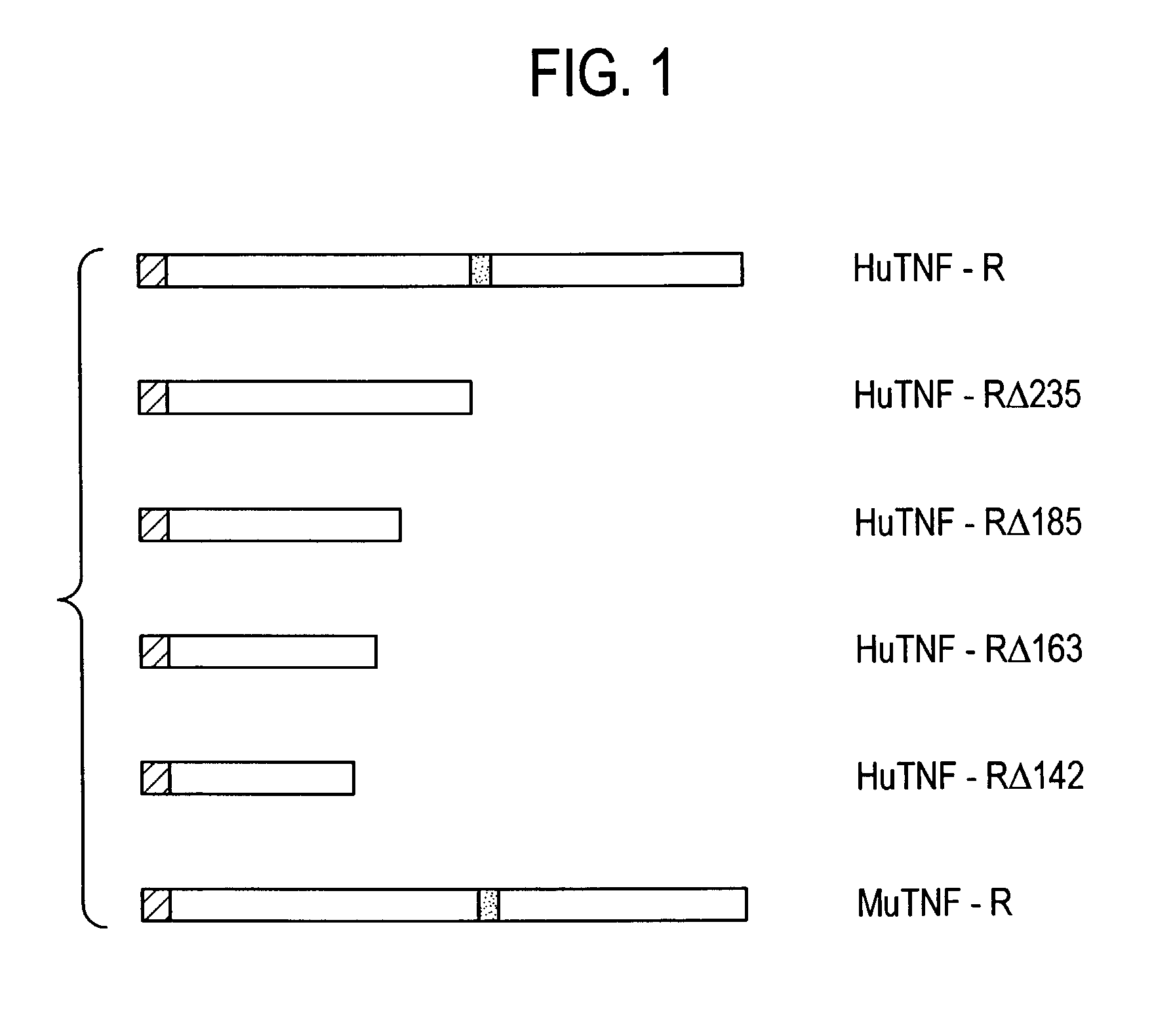Antibodies which specifically bind to TNF-R
a technology of tnf-r and antibodies, which is applied in the field of cytokine receptors, can solve the problems of tnf-r, impeded efforts to purify the tnf-r molecule for biochemical analysis, and low yield of compositions
- Summary
- Abstract
- Description
- Claims
- Application Information
AI Technical Summary
Benefits of technology
Problems solved by technology
Method used
Image
Examples
example 1
Binding Assays
[0075]A. Radiolabeling of TNFα and TNFβ. Recombinant human TNFα, in the form of a fusion protein containing a hydrophilic octapeptide at the N-terminus, was expressed in yeast as a secreted protein and purified by affinity chromatography (Hopp et al., Bio / Technology 6:1204, 1988). Purified recombinant human TNFβ was purchased from R&D Systems (Minneapolis, Minn.). Both proteins were radiolabeled using the commercially available solid phase agent, IODO-GEN (Piere). In this procedure, 5 μg of IODO-GEN were plated at the bottom of a 10×75 mm glass tube and incubated for 20 minutes at 4° C. with 75 μl of 0.1 M sodium phosphate, pH 7.4 and 20 μl (2 mCi) Na 125I. This solution was then transferred to a second glass tube containing 5 μg TNFα (or TNFβ) in 45 μl PBS for 20 minutes at 4° C. The reaction mixture was fractionated by gel filtration on a 2 ml bed volume of Sephadex G-25 (Sigma) equilibrated in Roswell Park Memorial Institute (RPMI) 1640 medium containing 2.5% (w / v) ...
example 2
Isolation of Human TNF-R cDNA by Direct Expression of Active Protein in COS-7 Cells
[0078]Various human cell lines were screened for expression of TNF-R based on their ability to bind 125I-labeled TNF. The human fibroblast cell line WI-26 VA4 was found to express a reasonable number of receptors per call. Equilibrium binding studies showed that the cell line exhibited biphasic binding of 125I-TNF with approximately 4,000 high affinity sites (Ka=1×1010 M−1) and 15,00 low affinity sites (Ka=1×108 M−1) per cell.
[0079]An unsized cDNA library was constructed by reverse transcription of polyadenylated mRNA isolated from total RNA extracted from human fibroblast WI-26 VA4 cells grown in the presence of pokeweed mitogen, using standard techniques (Gubler, et al., Gene 25:263, 1983; Ausubel et al., eds., Current Protocols in Molecular Biology, Vol. 1, 1987). The cells were harvested by lysing the cells in a guanidine hydrochloride solution and total RNA isolated as previously described (March...
example 3
Construction of cDNAs Encoding Soluble huTNF-RΔ235
[0086]A cDNA encoding a soluble huTNF-RΔ235 (having the sequence of amino acids 1–235 of SEQ ID NO: 1) was constructed by excising an 840 by fragment from pCAV / NOT-TNF-R with the restriction enzymes Not1 and Pvu2. Not1 cuts at the multiple cloning site of pCAV / NOT-TNF-R and Pvu2 cuts within the TNF-R coding region 20 nucleotides 5′ of the transmembrane region. In order to reconstruct the 3′ end of the TNF-R sequences, two oligonucleotides (encoding amino acids corresponding to Ala229-Ala235 of SEQ ID NO:1) were synthesized and annealed to create the following oligonucleotide linker:
[0087]
Pvu2 BamH1 Bgl2 CTGAAGGGAGCACTGGCGACTAAGGATCCA GACTTCCCTCGTGACCGCTGATTCCTAGGTCTAGAlaGluGlySerThrGlyAspEnd
This oligonucleotide linker has terminal Pvu2 and Bgl2 restriction sites, regenerates 20 nucleotides of the TNF-R, followed by a termination codon (underlined) and a BamHI restriction site (for convenience in isolating the enti...
PUM
| Property | Measurement | Unit |
|---|---|---|
| apparent molecular mass | aaaaa | aaaaa |
| apparent molecular mass | aaaaa | aaaaa |
| molecular weight | aaaaa | aaaaa |
Abstract
Description
Claims
Application Information
 Login to View More
Login to View More - R&D
- Intellectual Property
- Life Sciences
- Materials
- Tech Scout
- Unparalleled Data Quality
- Higher Quality Content
- 60% Fewer Hallucinations
Browse by: Latest US Patents, China's latest patents, Technical Efficacy Thesaurus, Application Domain, Technology Topic, Popular Technical Reports.
© 2025 PatSnap. All rights reserved.Legal|Privacy policy|Modern Slavery Act Transparency Statement|Sitemap|About US| Contact US: help@patsnap.com

